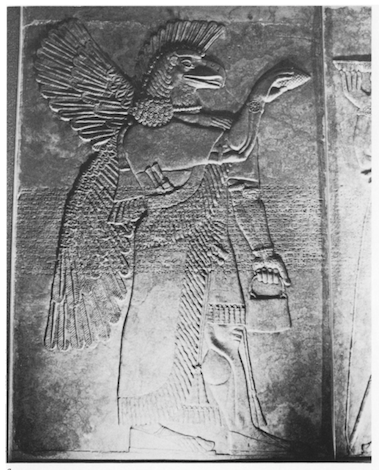From Anthony Green, Neo-Assyrian Apotropaic Figures, 1983
by Estéban Trujillo de Gutiérrez
“From Assyria and Babylonia in the first half of the first millennium BCE comes a series of small figurines in the round and relief plaques, which are usually found beneath the floors of buildings within receptacles of baked or unbaked brick or (at Nineveh) stone slabs or (so far restricted to Aššur) pottery jars; the figurines themselves are almost invariably of sun-dried clay, very occasionally, perhaps, of terracotta or metal.
(Note 1: E. Douglas Van Buren, Foundation Figurines and Offerings (Berlin, 1931) [henceforth referred to as FFO] is now outdated on this subject. For a synthesis of material mainly from published sources up to 1973, see Dessa Rittig, Assyrisch-babylonische Kleinplastik magischer Bedeutung vom. 13.-6. Fh v. Chr. (München, 1977) [henceforth Rittig]. The Nimrud corpus remains for the most part unpublished. A certain amount of new material, including Nimrud figurines, will appear in R.S. Ellis, Domestic Spirits: Apotropaic Figurines in Mesopotamian Buildings (Philadelphia, forthcoming)).
Their purpose, as texts prescribing the rituals involved attest, was to avert evil from the buildings and sickness from the inhabitants.
The British School’s Nimrud complement comprises at least 136 relevant pieces from 66 separate deposits discovered in three buildings: the Burnt Palace, the Acropolis Palace (AB) and Fort Shalmaneser, and dating possibly from the reign of Shalmaneser III (?) or, at least, Adad-nirari III down to the fall of the Assyrian Empire in 613 BCE.
In this paper I shall deal with just one, but perhaps the most important, area on which the series sheds light, namely the question of the identification of the creatures represented by the various iconographic types. It can hardly be denied that the study of apotropaic figurines is of somewhat limited importance in itself. Where it succeeds is rather in the light which it throws upon matters of more general and basic interest.
It is vital here to recognize the official nature of the ritual and practice, and the consequent position of the iconography of the figurines in the official religion of the Assyrian state. And while there are no apparent documentary sources directly concerning, for example, the subjects of the apotropaic palace reliefs, there are texts ordaining procedures for apotropaic rituals involving figurines, which often enable identifications of analogous types.
Professor Mallowan was quick to recognize the relationship between the so-called Nisroch or “Griffin-demon” common in the ninth-century palaces and in Middle and Neo-Assyrian art in general (Plate IXa), and the bird-headed human figurines of apkallē from Phase E of the Burnt Palace (Plate IXb).
Citing this instance, J.B. Stearns (Reliefs from the Palace of Ashurnasirpal II, AfO Behest 15 (Graz, 1961), 26, n. 44), has remarked that although there is here an isolated, rather superficial, relationship, there are no general correspondences between the figures on the reliefs and the actual or prescribed figurines, and that even in this case the connection does not aid our understanding of the monumental figures:
” . . . it is important to note that they are only one type out of many kinds of statuettes mentioned in these texts. Thus the parallel between the foundation-figures and the reliefs seems far from complete, since only the … winged, eagle-headed genie is present in the texts …
It should also be noted that among the several types of figurines excavated none except the bird-headed type seems to resemble the genies of the reliefs …
In short, the relationship between the apkallē of the typical text here adduced and the excavated figurines seems rather superficial, and the connection of either texts or the figurines with the rites depicted on the reliefs seems too tenuous to warrant basing an explanation of the reliefs upon such evidence.”
But although this appears true when considering the reliefs catalogued in Stearn’s restricted study, it is not the case when the full repertoire of apotropaic figures on the reliefs and in fictile art is considered, when a number of correlations can be found.
The method of using such correlations to identify individual figure types has already been well vindicated, I believe, in Dr. Julian Reade’s reappraisal of the subject-matter of Assyrian sculpture.”
Anthony Green, “Neo-Assyrian Apotropaic Figures,” Iraq, Vol. 45, 1983, pp. 87-8.


